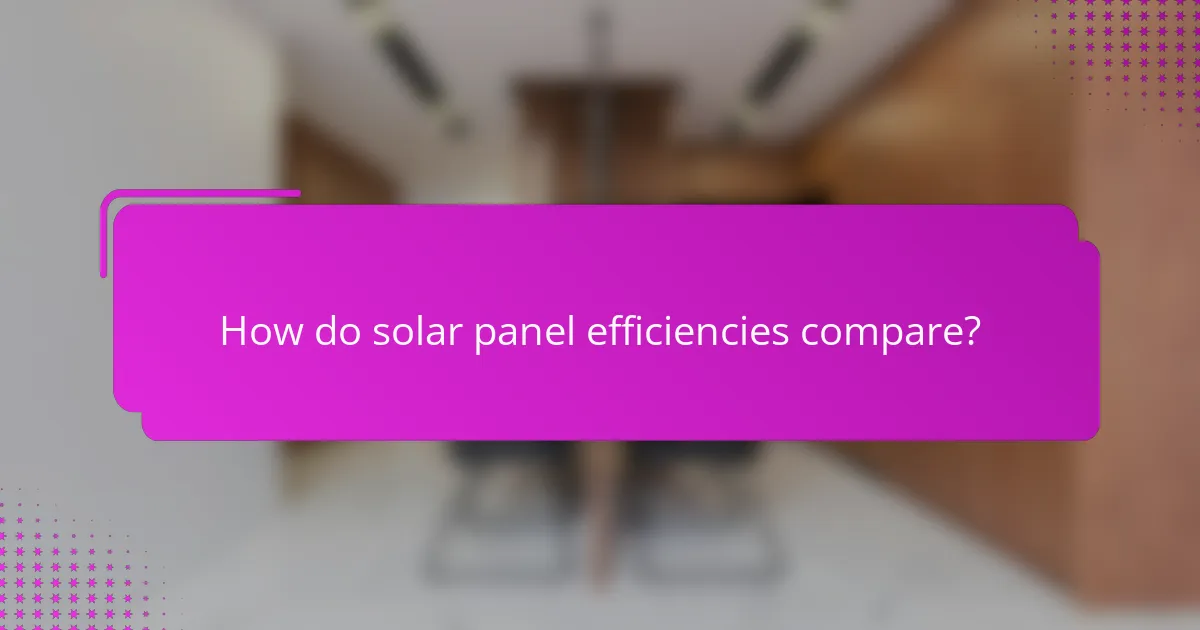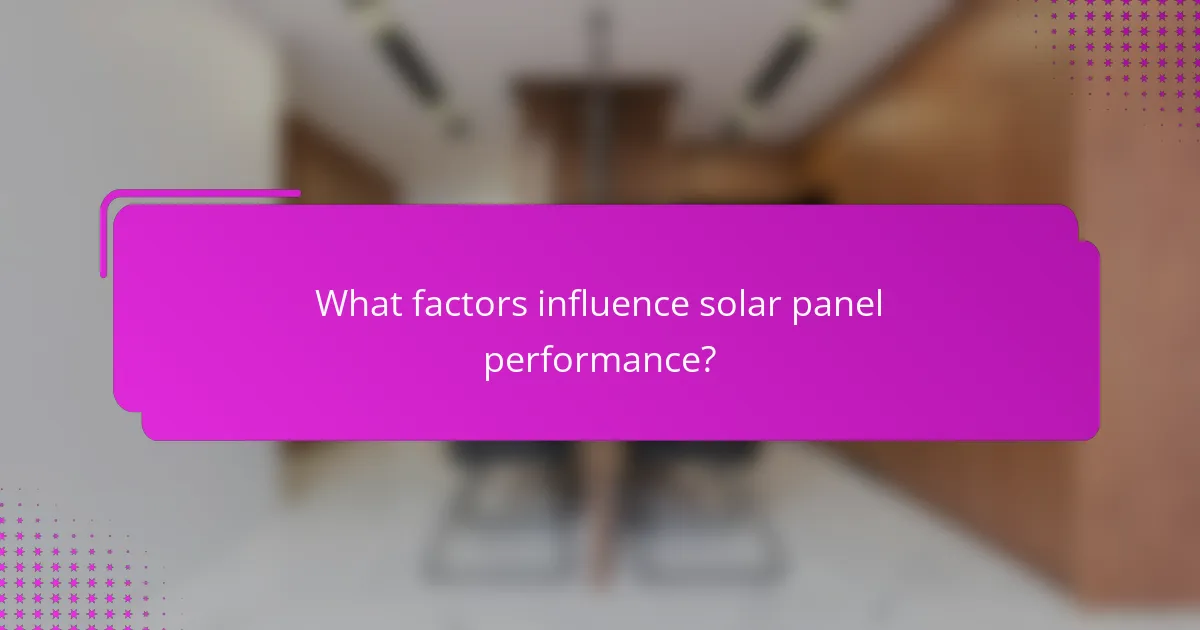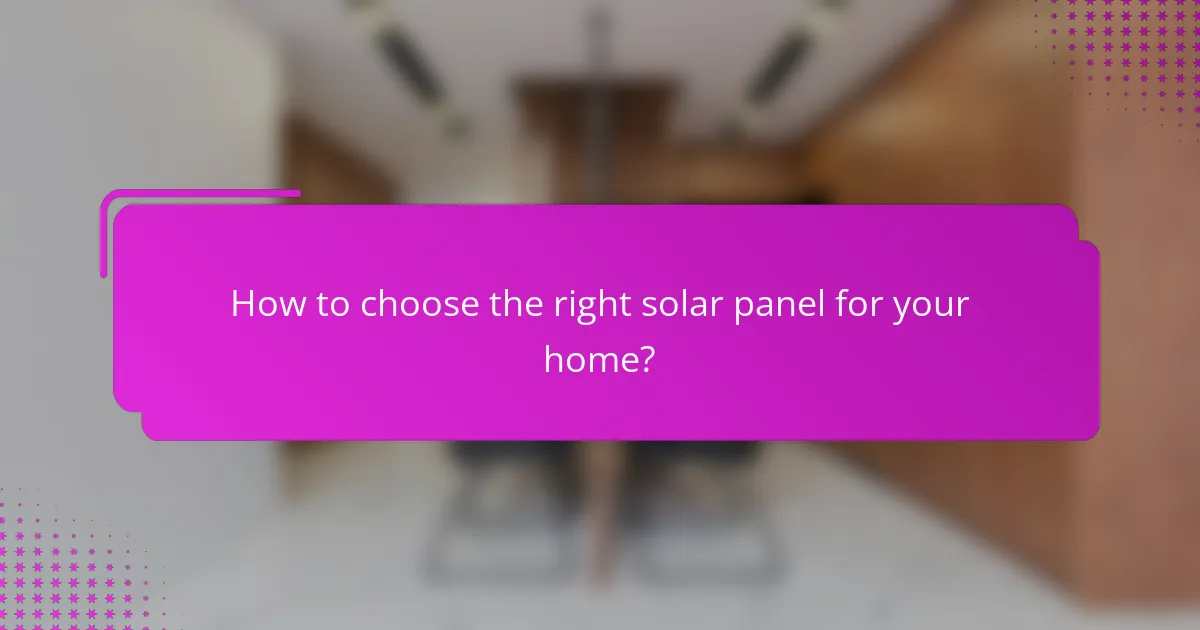When considering solar panel options for residential use, it’s essential to understand the various types available, including monocrystalline, polycrystalline, and thin-film panels, each with unique efficiency levels and costs. Installation expenses can range from $15,000 to $30,000 in California, influenced by factors like system size and complexity. Choosing the right type of solar panel is critical for optimizing energy output and ensuring cost-effectiveness.

What are the best solar panel types for residential use?
The best solar panel types for residential use include monocrystalline, polycrystalline, thin-film, bifacial, and building-integrated photovoltaics (BIPV). Each type has distinct characteristics, efficiency levels, and cost implications that can affect your choice based on your specific needs and installation conditions.
Monocrystalline solar panels
Monocrystalline solar panels are known for their high efficiency and sleek appearance. Made from a single crystal structure, they typically offer efficiency rates between 15% and 22%, making them a popular choice for homeowners with limited roof space.
These panels perform well in low-light conditions and have a longer lifespan, often exceeding 25 years. However, they tend to be more expensive, with costs ranging from $1 to $3 per watt, which can impact overall installation expenses.
Polycrystalline solar panels
Polycrystalline solar panels are created from multiple crystal structures, resulting in a less uniform appearance and slightly lower efficiency, generally between 13% and 16%. They are often more affordable than monocrystalline panels, with prices typically between $0.90 and $2.50 per watt.
While they may take up more space for the same energy output, polycrystalline panels are a solid choice for homeowners looking for a cost-effective solution. Their performance is slightly less efficient in high temperatures compared to monocrystalline options.
Thin-film solar panels
Thin-film solar panels are lightweight and flexible, making them suitable for a variety of applications, including unconventional rooftops. Their efficiency ranges from 10% to 12%, which is lower than crystalline options, but they can perform better in high temperatures and low-light conditions.
These panels are generally the least expensive, costing around $0.50 to $1.50 per watt. However, their larger surface area requirements may necessitate more space for installation, which can be a consideration for residential setups.
Bifacial solar panels
Bifacial solar panels capture sunlight from both sides, increasing their overall energy production. This dual-sided design can yield efficiency gains of 10% to 20% compared to traditional panels, depending on installation conditions and reflective surfaces nearby.
While they are more expensive, typically ranging from $1.50 to $3.50 per watt, the added energy output can justify the higher initial investment, especially in areas with high albedo surfaces like white roofs or sandy environments.
Building-integrated photovoltaics (BIPV)
Building-integrated photovoltaics (BIPV) are solar panels integrated directly into building materials, such as roofs or facades. This approach allows for energy generation without compromising aesthetics, making them appealing for new constructions or renovations.
While BIPV can be more costly than traditional panels, often exceeding $3 per watt, they can reduce overall building material costs and provide energy savings. Their effectiveness depends on design and orientation, so careful planning is essential for optimal performance.

What are the costs associated with solar panel installation in California?
The costs for solar panel installation in California can vary significantly based on factors such as system size, panel type, and installation complexity. Generally, homeowners can expect to spend between $15,000 and $30,000 for a residential solar system before any incentives or rebates are applied.
Average installation costs
The average installation cost for solar panels in California typically ranges from $2.50 to $3.50 per watt. For a standard 6 kW system, this translates to a total cost of approximately $15,000 to $21,000. Factors influencing these costs include the quality of the panels, labor rates, and any additional equipment needed.
It’s essential to obtain multiple quotes from licensed installers to ensure competitive pricing. Additionally, consider the long-term savings on electricity bills when evaluating the upfront investment.
Cost breakdown by panel type
Solar panels come in various types, each with different price points and efficiencies. Monocrystalline panels are generally the most efficient and cost between $1,000 and $1,500 per panel, while polycrystalline panels are slightly less efficient and typically range from $800 to $1,200 per panel. Thin-film panels are the least expensive but also the least efficient, costing around $500 to $1,000 per panel.
When selecting a panel type, consider not only the initial cost but also the efficiency and warranty offered. Higher efficiency panels may have a higher upfront cost but can lead to greater savings over time due to increased energy production.
Incentives and rebates available
California offers several incentives and rebates to help offset the costs of solar panel installation. The most significant is the federal solar tax credit, which allows homeowners to deduct a percentage of the installation costs from their federal taxes. As of 2023, this credit is set at 30% of the total system cost.
Additionally, California has state-specific programs such as the California Solar Initiative (CSI) and various local utility rebates that can further reduce installation costs. Homeowners should research available incentives and consult with their installer to maximize savings.

How do solar panel efficiencies compare?
Solar panel efficiencies vary significantly among different types, impacting their performance and cost-effectiveness. Monocrystalline panels typically offer the highest efficiency, while thin-film panels tend to be the least efficient, making the choice of panel type crucial for maximizing energy output.
Efficiency of monocrystalline panels
Monocrystalline panels are known for their high efficiency, often exceeding 20%. This efficiency is due to the purity of the silicon used, which allows for better electron flow. They are ideal for limited space installations, as they produce more power per square meter compared to other types.
However, they tend to be more expensive, with costs ranging from $1 to $3 per watt. When considering installation, the higher initial investment can be offset by long-term energy savings, making them a popular choice for residential and commercial applications.
Efficiency of polycrystalline panels
Polycrystalline panels generally have lower efficiencies, typically between 15% and 20%. The manufacturing process involves melting multiple silicon crystals together, which results in a less efficient electron flow compared to monocrystalline panels. They are a cost-effective option for larger installations where space is less of a concern.
Prices for polycrystalline panels usually fall between $0.80 and $1.50 per watt, making them more budget-friendly. While they may require more space to generate the same amount of power as monocrystalline panels, they still offer a solid return on investment for many users.
Efficiency of thin-film panels
Thin-film panels are the least efficient, with efficiencies typically ranging from 10% to 13%. They are made by depositing a thin layer of photovoltaic material on a substrate, which allows for flexibility and lightweight designs. This makes them suitable for specific applications like building-integrated photovoltaics.
Despite their lower efficiency, thin-film panels are often less expensive, costing around $0.50 to $1 per watt. However, their larger area requirement for the same energy output can be a drawback, especially in space-constrained environments. Users should weigh the trade-offs between cost and efficiency when considering this option.

What factors influence solar panel performance?
Solar panel performance is influenced by several key factors, including climate, roof orientation, shading, and the quality of installation. Understanding these elements can help maximize energy production and efficiency.
Climate and weather conditions
Climate and weather significantly impact solar panel efficiency. Regions with high sunlight exposure, such as the southwestern United States, generally see better performance compared to cloudier areas. Temperature also plays a role; while panels are more efficient in cooler conditions, excessive heat can reduce their output.
Consider local weather patterns when assessing solar potential. For example, areas prone to heavy snowfall may require additional maintenance, while those with frequent storms might need more durable equipment. Always check historical weather data to gauge expected performance.
Roof orientation and shading
The orientation of your roof is crucial for solar panel performance. South-facing roofs typically capture the most sunlight in the Northern Hemisphere, while east and west orientations can still be effective, albeit with reduced efficiency. A roof’s angle also affects how much sunlight panels receive throughout the day.
Shading from trees, buildings, or other obstructions can significantly decrease solar output. It’s essential to assess potential shading throughout the year, as even partial shading can lead to substantial energy losses. Consider trimming trees or selecting panel locations that minimize shading.
Installation quality
The quality of installation directly affects solar panel performance and longevity. Proper mounting, wiring, and system configuration are essential for optimal energy production. Poor installation can lead to issues such as leaks, electrical failures, or reduced efficiency.
When selecting an installer, look for certifications and positive reviews. Ensure they follow local building codes and standards. A well-installed system can enhance performance by 10-20% compared to a poorly installed one, making it a critical factor in your solar investment.

How to choose the right solar panel for your home?
Choosing the right solar panel for your home involves assessing your energy needs, evaluating available roof space, and comparing warranties and lifespans. Each of these factors plays a crucial role in determining the most suitable solar panel system for your specific situation.
Assessing energy needs
Start by calculating your household’s energy consumption, typically measured in kilowatt-hours (kWh). Review your utility bills to find your average monthly usage, which can range from a few hundred to several thousand kWh depending on the size of your home and lifestyle.
Once you have this figure, consider how much of that energy you want to offset with solar panels. A common goal is to cover 70-100% of your energy needs, which can significantly reduce your electricity bills. Use online calculators or consult with solar providers to estimate how many panels you’ll need based on your energy goals.
Evaluating roof space
Assessing your roof space is essential for determining how many solar panels can fit. Measure the area available for installation, taking into account any obstructions like chimneys or vents. Ideally, a south-facing roof with minimal shading will yield the best results.
As a rule of thumb, each solar panel requires about 15-20 square feet of space. If your roof is limited, consider options like ground-mounted systems or solar canopies, which can maximize energy production without compromising aesthetics.
Comparing warranties and lifespans
When selecting solar panels, pay attention to warranties and expected lifespans. Most panels come with a performance warranty of 25 years, ensuring they will produce a certain percentage of their rated output over time. Additionally, check for product warranties that cover defects, which typically range from 10 to 25 years.
Longer warranties often indicate higher quality, but also consider the manufacturer’s reputation and customer service. Research reviews and ratings to ensure you choose a reliable brand that stands behind its products, as this can impact your long-term satisfaction and system performance.


